Star Trek: Deep Space Nine (DS9) is an American science fiction television series created by Rick Berman and Michael Piller. The fourth series in the Star Trek media franchise, it originally aired in syndication from January 3, 1993, to June 2, 1999, spanning 176 episodes over seven seasons. Set in the 24th century, when Earth is part of a United Federation of Planets, its narrative is centered on the eponymous space station Deep Space Nine, located adjacent to a wormhole connecting Federation territory to the Gamma Quadrant on the far side of the Milky Way galaxy.
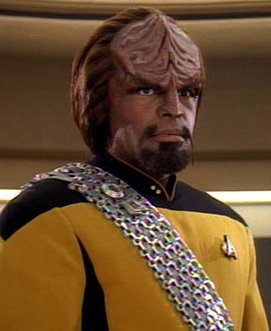
Worf, son of Mogh is a fictional character in the Star Trek franchise, portrayed by actor Michael Dorn. He appears in the television series Star Trek: The Next Generation (TNG), seasons four through seven of Star Trek: Deep Space Nine (DS9) and the third and final season of Star Trek: Picard, as well as the feature films Star Trek Generations (1994), Star Trek: First Contact (1996), Star Trek: Insurrection (1998), and Star Trek: Nemesis (2002).
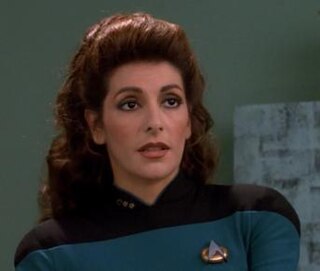
Deanna Troi is a main character in the science-fiction television series Star Trek: The Next Generation and related TV series and films, portrayed by actress Marina Sirtis. Troi is half-human, half-Betazoid, and has the psionic ability to sense emotions. She serves as the ship's counselor on USS Enterprise-D. Throughout most of the series, she holds the rank of lieutenant commander. In the seventh season, Troi takes the bridge officer's examination and is promoted to the rank of commander, but continues as counselor.

Starfleet is a fictional organization in the Star Trek media franchise. Within this fictional universe, Starfleet is a uniformed space force maintained by the United Federation of Planets as the principal means for conducting deep space exploration, research, defense, peacekeeping, and diplomacy. While most of Starfleet's members are human and it has been headquartered on Earth, hundreds of other species are also represented. Most of the franchise's protagonists are Starfleet commissioned officers.
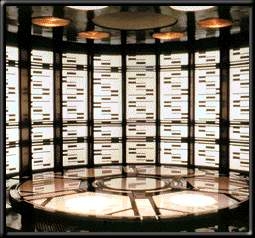
A transporter is a fictional teleportation machine used in the Star Trek science fiction franchise. Transporters allow for teleportation by converting a person or object into an energy pattern, then sending ("beaming") it to a target location or else returning it to the transporter, where it is reconverted into matter ("rematerialization"). Since its introduction in Star Trek: The Original Series in 1966, the name and similar concepts have made their way to other science fiction scenarios, in literature, games (SimEarth), etc.
In the fictional universe of Star Trek, the Prime Directive is a guiding principle of Starfleet that prohibits its members from interfering with the natural development of alien civilizations. Its stated aim is to protect unprepared civilizations from the danger of starship crews introducing advanced technology, knowledge, and values before they are ready. Since its introduction in the first season of the original Star Trek series, the directive has featured in many Star Trek episodes as part of a moral question over how best to establish diplomatic relations with new alien worlds.
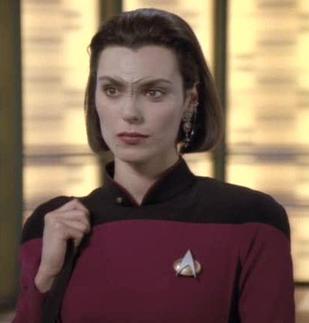
Ro Laren is a fictional character appearing on a recurring basis in the fifth, sixth, and seventh seasons of the American science-fiction television series Star Trek: The Next Generation. The character returned for the third season of Star Trek: Picard. Portrayed by Michelle Forbes, she is a member of the Bajoran species who joins the crew of the USS Enterprise-D over the fervent objection of Captain Jean-Luc Picard, who cited her previous court-martial. Ro, too, was against joining the Enterprise crew but said, "It is better than prison." The character was intended both to be at odds with the series regulars and to replace Wesley Crusher at the conn officer post on the bridge. Forbes was cast to portray Ro after previously appearing in the series as Dara in the episode "Half a Life".
A universal translator is a device common to many science fiction works, especially on television. First described in Murray Leinster's 1945 novella "First Contact", the translator's purpose is to offer an instant translation of any language.
This article discusses the fictional timeline of the Star Trek franchise. The franchise is primarily set in the future, ranging from the mid-22nd century to the late 24th century, with the third season of Star Trek: Discovery jumping forward to the 32nd century. However the franchise has also outlined a fictional future history of Earth prior to this, and, primarily through time travel plots, explored both past and further-future settings.
"The Siege" is the 23rd episode of the American science fiction television series Star Trek: Deep Space Nine. It is the third in a three-part story arc, and the third episode of the second season.
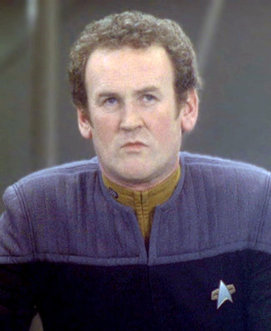
Miles Edward O'Brien is a character in the Star Trek franchise, portrayed by actor Colm Meaney. O'Brien appears occasionally in all seven seasons of Star Trek: The Next Generation and is a main cast member of Star Trek: Deep Space Nine. O'Brien was originally the transporter chief of the USS Enterprise-D. He was later promoted to chief of operations of Deep Space Nine. Being portrayed in 225 episodes overall, O'Brien is the Star Trek character with the second most appearances in the Star Trek franchise, second only to Worf.
"Call to Arms" is the 26th and final episode of the fifth season of the science fiction television series Star Trek: Deep Space Nine, the 124th episode overall. This episode marks the start of the show's celebrated Dominion war story arc.
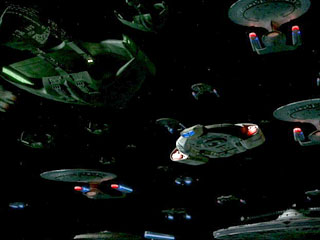
"What You Leave Behind" is the series finale of the television show Star Trek: Deep Space Nine, the 175th and 176th episodes, the 25th and 26th episodes of the seventh season. The episode was written by showrunner Ira Steven Behr and Hans Beimler and directed by Allan Kroeker. It originally aired the week of May 31, 1999.
Star Trek uniforms are costumes worn by actors portraying personnel of a fictitious Starfleet in various television series and films in the Star Trek science fiction franchise. The costume design often changed in the various series, to represent different time periods, and for reasons of appearance and comfort. Sometimes different styles were deliberately mixed to enhance the sense of time travel or alternative universes.
"A Time to Stand" is the first episode of the sixth season of the television series Star Trek: Deep Space Nine, and the 125th episode overall. This episode was broadcast on television starting on September 29, 1997.

Deep Space Nine is a fictional space station, the eponymous primary setting of the American science fiction television series Star Trek: Deep Space Nine which aired from 1993 to 1999. It serves as a base for the exploration of the Gamma Quadrant via the Bajoran wormhole and is a hub of trade and travel for the sector's denizens. It is run by a joint crew of Starfleet and Bajoran officers and it is the home port of a number of Starfleet runabouts, as well as the starship USS Defiant.

Larry Nemecek is an American writer, speaker and host best known for his work in various capacities regarding the Star Trek franchise.












